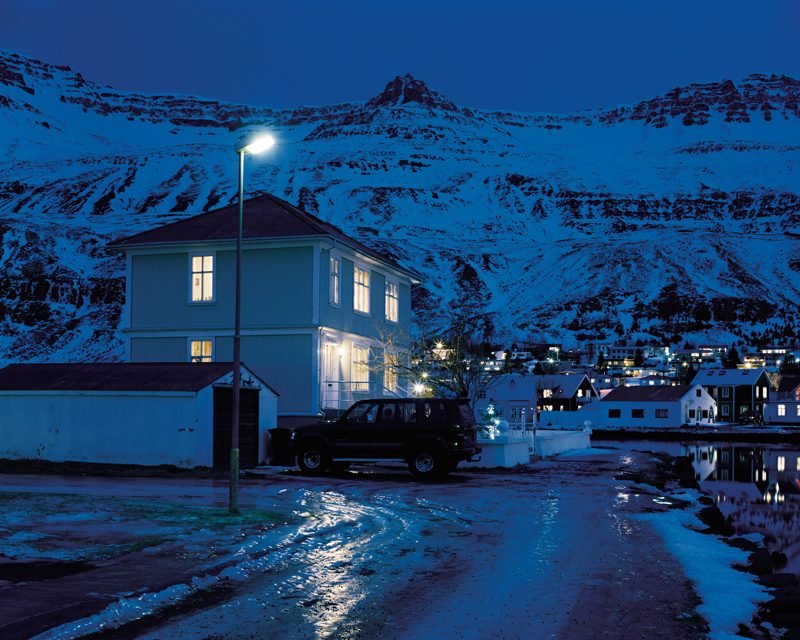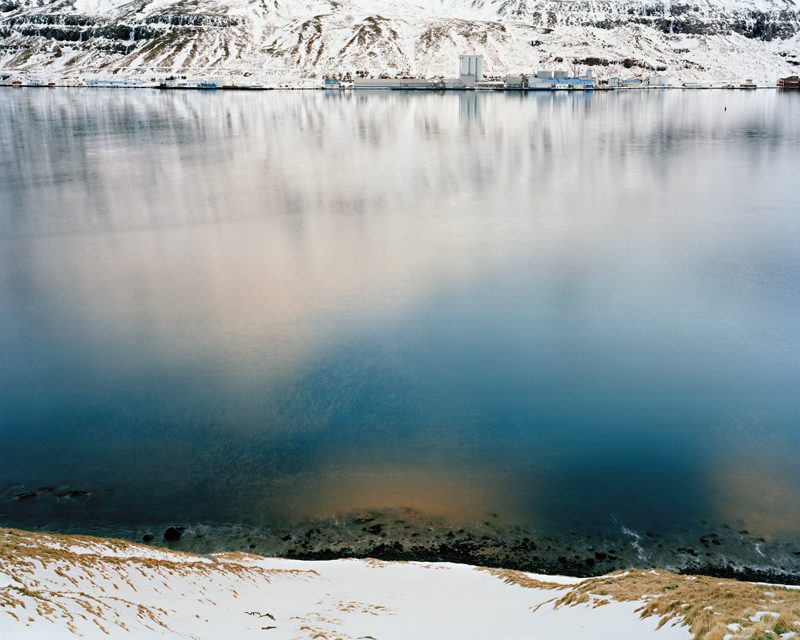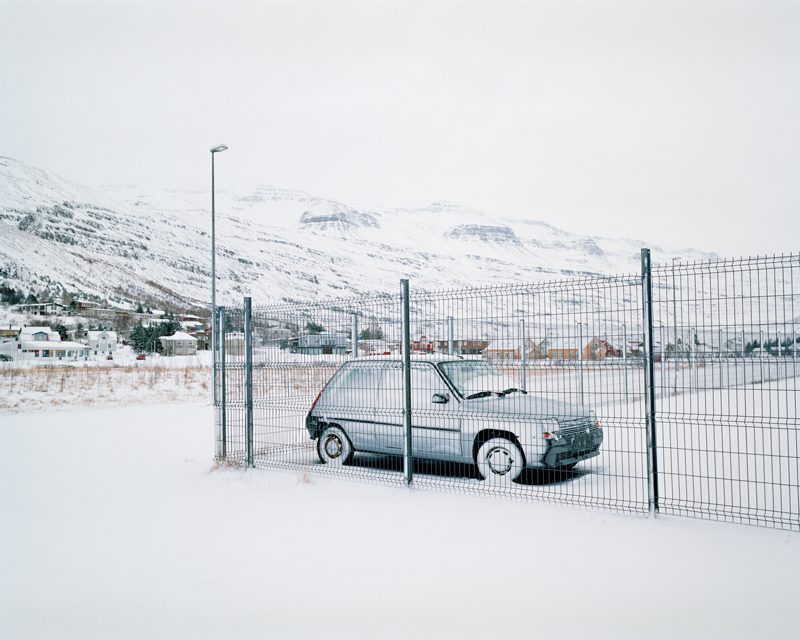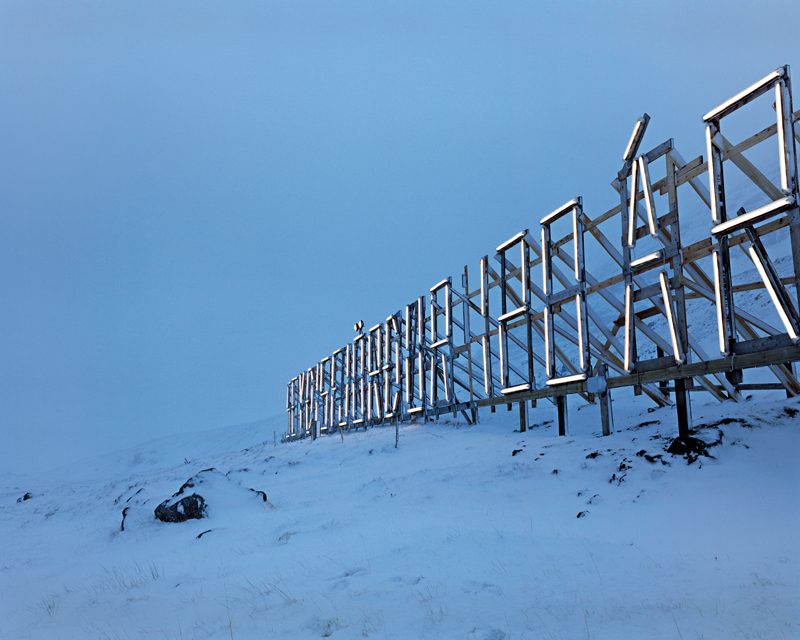Who better than a seasoned photographer to explore the phenomenology of light? Jessica Auer’s recent series January, created during a 2015 residency in Seyðisfjörður, Iceland, is a thematic work of great visual poetry the resonance of which lingers within us like a memory of bluer-than-blue Icelandic light, long after we have left the exhibition halls.
Diaristic in nature, and allegorical in its mien, Auer’s work defines her environment discursively and not in terms of objects or mute things, or even people and relationships, but in terms of the infinite configurations and gradients of Icelandic light itself. That strangely ethereal blue light infuses everything it touches with sidereal grace and a hauntingly gravid eloquence. This work seems to take a cue from Claudel’s famous statement that “a certain blue of the sea is so blue that only blood would be more red.”1
Of her first morning in Iceland, the artist said, in the press release accompanying her show, “I alternated between each of the seven windows of my studio apartment, craning my neck to look up the valley, down the fjord, up the mountain slopes, and around all the other houses. It was 10 a.m. and the morning light maintained a dark deep blue. As the day carried on, the sun never broke the mountains, but circled around the peaks – gracing only the tops of the opposing ridges with direct light. I was told that the sun would only find the town again in February.” That hallmark dark blue is beautifully captured in a C-print emblematic of the whole project, Studio (January 27th) (2015).
In what is perhaps her most personal work to date, Auer recognized from the outset of her sojourn in Seyðisfjörður that she would have to jettison the constraints of her usual research-oriented approach and embrace the folklore of the moment wherein she found herself. Like Tangle, the wily heroine of George Macdonald’s famous story “The Golden Key,” who must follow a path without stairs or signposts to reach a land in which the most beautiful shadows are cast, Auer had to free-fall like a skydiver without recourse to the parachute of theory to secure an enduring truth of the Icelandic landscape. In the story, the Old Man of the Earth instructed Tangle: “That is the way,” he said. “But there are no stairs.” “You must throw yourself in. There is no other way.”2 So Auer threw herself in, gave herself up to chance, desire, circumstance, and the unknown, followed an itinerary without paths, and focused on walking every day as an artistic activity, within the limits of the short daylight hours, to see where that would lead her.
Auer began the project with a medium-format camera (a Mamiya 7) but early on it met with a fatal accident in the snow, and she turned to her trusty 4″ x 5″ view camera made by Chamonix and used colour film. (The video was shot using a DSLR camera.) Most of the prints in her recent exhibition at Galerie Patrick Mikhail in Montreal are C-prints on real photographic paper, and the lightbox prints are on Duratrans, with a few exceptions. (The exceptional Neon (January 12th) was printed on backlit paper and mounted in a light box, and the magisterial large floor piece Sunrise (January 20th) is on vinyl adhesive.)
Auer has a long history as one of the foremost documentary-style landscape photographers based in Montreal. She travels widely and practises a sort of social archaeology, showing how landscape has been turned into a commodity for tourism. We are asked to reflect upon the cultural and historical baggage of those places and our own role in their constitution. Given her aesthetic, it is all the more remarkable that, in January, Auer can conjure the noumenal out of the Icelandic air like a Houdini of the photographic image pulling a rabbit out of a hat. Also, as is her wont, Auer injects a full measure of the uncanny into what seem at first idyllic snow-capped peaks placed geographically far above the fray. In works so large – one is the subject of a 45-minute video work, Where the Mountains Meet the Sun (HD video installation, 45 min. looped, 2015) with an associated image laminated onto the adjacent floor of the gallery space, the aforementioned Sunrise (January 20th) – we are effortlessly projected into and held taut within them.
Clearly, Auer shares with Danish-Icelandic artist Olafur Eliasson themes and concerns that stem from Maurice Merleau-Ponty’s phenomenalism. The viewer finds it impossible to remain passive or unmoved in the face of the Icelandic landscape and its radiant blue light in images such as Dusk (January 26th) and the remarkably compelling Fjord (January 27th). Auer encourages us to consider luminosity, time, and place. As Sasha Engelmann has argued for Eliasson’s work, In essence, the tenets of phenomenalism provide the politicizing potential in Eliasson’s installations, loosening the frames through which the audience is accustomed to viewing environments. The experience is humbling; viewers are introduced into a “being in common” and absorb a sense of unity in the reception of sense data. Merleau-Ponty illustrates this sense of sharing experience: “The world is precisely that thing of which we form a representation, not as men or as empirical subjects, but in so far as we are all one light and participate in the One without destroying its unity.”3
In describing the wherewithal of an engaged relationship with an object, Merleau-Ponty states, “But the system of experience is not arrayed before me as if I were God, it is lived by me from a certain point of view; I am not the spectator, I am involved, and it is my involvement in a point of view which makes possible both the finiteness of my perception and its opening out upon the complete world as a horizon of every perception.”4 In perceiving Auer’s remarkable photographs, we become the work, we are the work, and thus open to alteration. As Merleau-Ponty remarks, our perceptions expand onto the “complete world,” demonstrating a mensurable con.sequence of the artistic experience: we are now ineluctably changed by what has laid its claim upon us. In experiencing the works in Auer’s January, we recognize our own alteration, and are grateful for that recognition, and for observance of the change. In this work, Auer offers us living proof of the philoso.pher’s argument.
Auer’s photographs are a potent exploration of the phenomenology of light even as they mark a transit from the humbling banality of the here and now to a resplendent elsewhere heretofore beyond our ken. Merleau-Ponty held that, as we cross that line, “we are not cameras, we are engaged perceivers.”5 As we experience the captivating blue light that suffuses one of the most overwhelmingly lonely, isolated places on the planet, we are endlessly engaged, for we know that we are in the capable hands of a guide who is both artistic savant and triumphant shaman.
2 George MacDonald, The Golden Key and Other Stories (Grand Rapids: Wm. B. Eerdmans Publishing Co., 2000), 46.
3 Sasha Engelmann, “Breaking the Frame: Olafur Eliasson’s Art, Merleau-Ponty’s Phenomenology, and the Rhetoric of Eco-Activism,” in Stanford Undergraduate Journal for Excellence in Writing (2008); reprinted online in art& education, http://www.artandeducation.net/paper/breaking-the-frame-olafur-eliassons-art-merleau-pontys-phenomenology-and-the-rhetoric-of-eco-activism/.
4 Maurice Merleau-Ponty, The Phenomenology of Perception, trans. Colin Smith (London: Routledge, 2002), 354.
5 See Sean D. Kelly, “The Normative Nature of Perceptual Experience,” in Perceiving the World, ed. Bence Nanay (New York: Oxford University Press, 2014), 148.
Jessica Auer is a photographer and visual artist whose work is broadly concerned with the study of landscapes as cultural sites. She received her MFA in studio arts from Concordia University in 2007 and has since exhibited across Canada and abroad and participated in numerous international artist residencies. Her first book, Unmarked Sites, was noted by Photo-Eye and the Indie Photobook Library as one of the top ten photography books published in 2011. She teaches photography at Concordia University and is represented by Patrick Mikhail Gallery in Montreal. jessicaauer.com
James D. Campbell is a writer and curator who writes frequently on photography and painting from his base in Montreal.






